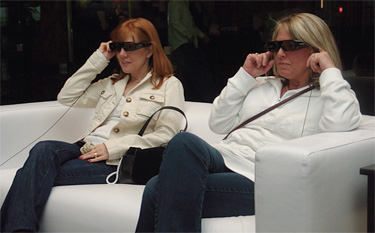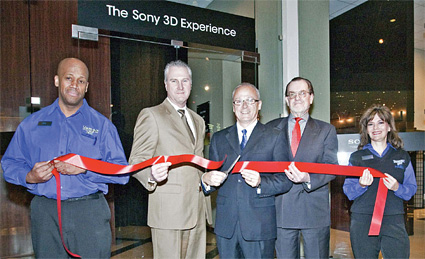Sony 3D Experience Celebrates First Anniversary
LAS VEGAS—CBS Vision and Sony Electronics will celebrate their first anniversary as 3D hub partners this month.

The Sony 3D Experience is located in the MGM Grand Last March, they launched “The Sony 3D Experience” research center and screening room to the public. The goal of the venture, located in CBS Vision’s Television City research facility at the MGM Grand Hotel & Casino, was to assess consumer preferences and perceptions toward 3D programming, and to determine how to best deliver 3D content for viewing both in and out of the home.
Since then, more than 125,000 people have taken the 3D tour, said David Poltrack, Chief Research Officer and President of the CBS network’s research arm, CBS Vision.
Poltrack said his goal was to continue showcasing “all of the latest, greatest entertainment technology”—in essence creating a mini-Consumer Electronics Show experience each day. He saw Television City as a means to provide promotional opportunities for technology partners as well as a place to gather feedback on all new technologies affecting the industry.
“As soon as anything comes out that has any relevance to our business, we test it independent of having any client [relationship],” said Poltrack. As for the newest test items on his wish list, he said, “We’re talking about getting some of the smaller 3D devices—3D cell phones and tablets.”
EVOLUTION OF THE 3D MECCA
Television City initially opened in April 2001 to test television programming. Down the road, the facility expanded into an adjacent location in order to accommodate a second facility for technology research.
“The [second] facility was designed to bring on all different players,” said Poltrack. “But Sony made the commitment to take all the space for that first year for the 3D experience.”
Sony has contracted the 4,000 square foot space through July of this year.

Attendees check out the 3D CBS Vision uses the remaining 6,000 square feet of its facility to conduct research for CBS and other content providers, websites and alternative technologies. Its techniques incorporate traditional qualitative and quantitative methods (like focus groups and surveys), as well as advanced bio-metric methods (such as eye tracking and brain scanning using NeuroFocus technology).
MARKET RESEARCH
3D movie trailers are shown in a special theatre. A model condo formerly used for real estate sales has been converted into a family room setting for watching content and playing motion detector-based video games on a Sony 3D IPTV using active [3D] glasses.
The consumer research gleaned on site has helped Sony shape and drive much of its strategy to build consumer awareness, said Sony officials, as well as to replicate an ideal consumer 3D experience at retail stores.
According to Carl Li, senior manager of product market research for Sony Electronics, one clear benefits of working with Television City is the ability to quickly gather opinions from a unique cross section of regionally diverse consumers who congregate at a single location.
“Last summer we used the CBS TV City research facility and some advanced media measuring technologies to test a large library of available 3D video content,” said Li “This allowed us to understand what types of 3D content are most appealing to consumers. From this, we created retail demonstrations that have helped increase consumer interest.”

The Sony 3D Experience is just one of Sony’s initiatives in the 3D arena. The company also operates its new 3D Technology Center on the Sony Pictures Entertainment lot in Culver City, Calif., which offers industry professionals the opportunity to learn more about the techniques and equipment for 3D production and content creation.
CONSUMER FEEDBACK
Last year Television City conducted surveys of specific 3D events (theatrical presentations of the NCAA Men’s Division I Basketball finals and Masters Golf tournament) as well as periodical surveys of visitors to the Sony 3D Experience and a joint study with Nielsen conducted for the Cable & Telecommunications Association for Marketing. It recently concluded its Annual New Technology survey, which tested 3DTV technology as well as various forms of IPTV.
Although CBS’ Poltrack believes that people are very impressed with 3DTV, he conceded there are obstacles to its adaptation. For starters, a relatively small percentage of viewers are physically incapable of processing 3D or are negatively impacted by the experience.
But the biggest drawbacks are the lack of 3D content and the too high price tag on available TV sets.
“The 3D [components] don’t really add much to the cost of the set,” said Poltrack. “But 3D right now is featured on large sets—the 3D sets that we are demonstrating are in the $1500 and above range.”
Moreover, he noted, as a result of the digital conversion and attraction of watching HDTV on a flatscreen, the majority of those surveyed had bought a TV in the last couple of years. They indicated that they were not likely to buy another in the near future.
Get the TV Tech Newsletter
The professional video industry's #1 source for news, trends and product and tech information. Sign up below.
